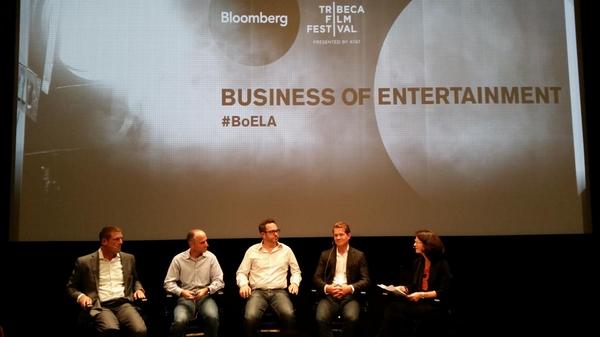Déjà vu all over again
 Tuesday, October 7, 2014 at 1:49 PM by
Tuesday, October 7, 2014 at 1:49 PM by  Nick DeMartino
Nick DeMartino It was déjà vu all over again, the feeling I had leaving last week’s “Business of Entertainment” panel at CAA headquarters. Welcome to a media business that seems to be looking a lot like the way cable TV emerged in the 80s as our dominant business model. (Video of the session is here.)
Forget all that talk of “disruption” and “revolution” and just take for granted that we’re living in a world where digital natives rule, watching their content as digital files or streams on mobile devices.
 The event, organized by Tribeca Enterprises and Bloomberg, featured four top exex from leading digital video companies – Disney's Kevin Mayer (re: Maker Studios), Machinima CEO Chad Gutstein , Vimeo CEO Kerry Trainor, Funny or Die CEO Dick Glover, ably moderated by Bloomberg’s Katherine Oliver
The event, organized by Tribeca Enterprises and Bloomberg, featured four top exex from leading digital video companies – Disney's Kevin Mayer (re: Maker Studios), Machinima CEO Chad Gutstein , Vimeo CEO Kerry Trainor, Funny or Die CEO Dick Glover, ably moderated by Bloomberg’s Katherine Oliver
To state the obvious, these folk all assume that the entertainment biz is all about digital video, and that we’re in an era defined by YouTube. Theirs is a vast ocean within which all fish swim. This panel was about the cross-currents in that ocean, e.g., trends such as:
- Diversification of syndication networks for talent, built atop of YouTube (MCNs like Maker and Machinima);
- Standalone content sites with new strategies for their original content (Funny or Die);
- Premium VOD services built atop YouTube competitors (Vimeo);
- New forms of longform TV distribution that starts as digital (Machinima).
Today we have a giant video ecosystem with multiple windows: just more of them, and in ever-shifting order, depending upon the type of talent and the property, as well as variables like length, target audience and budget.
These are simply facts of life as these savvy operators, all of them with career experience at “old media" firms, are placing bets on how this new order will deliver audiences and profits. It’s a world which proclaims that content is king, but truthfully, what I heard was that the container for that content (distribution) is king. Or the business model that enables somebody to make a buck, that always trumps content.
Which is why I was flashbacking, back to the origins of today’s incumbent media empires, namely cable TV, which married a robust distribution system with a new paradigm for content networks, much of it from startup firms (ESPN, MTV, CNN, HBO). Their growth led to acquisitions followed by tremendous investment by “old” media (networks, publishers), and market rationalization that enabled lots of money to be made.
And so today we see many of these business patterns emerging among and between the start-ups and the incumbents as everyone is sprinting for the prize in a significantly changed world featuring tens of thousands of creators available worldwide to audiences at the press of a button.
Some tidbits from the panel:
- “YouTube is about audiences connecting with talent who create & recommend content... but you start with compelling content," said Disney’s Kevin Mayer.
- If YouTube is online equivalent of broadcast TV, Vimeo is "the internet manifestation of .... premium cable," said Vimeo CEO Kerry Trainor, who is busy poaching YouTube talent for Vimeo’s new VOD service.
- “Seven years ago, everyone needed to be on YouTube. Now everyone on YouTube is looking to build businesses off it, " said Glover.
- "There are tens of millions of people tuning in to watch other people play video games," according to Machinima's Gutstein, calling it the new appointment viewing (a la Twitch).
- “Internet is going nuclear with young audiences, but it is not to detriment of television. The best long form ever is being created on TV,” says Glover.
- "Content is king, whether snack size to Twitch to thirteeen-hour binge," said Mayer.

